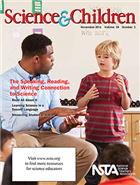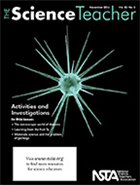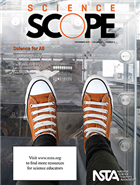Ideas and inspiration from NSTA’s November K-12 journals
By Mary Bigelow
Posted on 2016-11-22
Educators at all levels will find ideas on helping students with Meeting the Challenges of Communicating Science in his month’s Science and Children. Many of the strategies can be adapted for other levels.
 Science and Children – The Speaking, Reading, and Writing Connection to Science
Science and Children – The Speaking, Reading, and Writing Connection to Science
This issue is a must-read for teachers of all levels. The lessons described in the articles include connections with the NGSS.
- Read All About It has a good visual of how genres of children’s books can contribute different perspectives to children’s knowledge of and about science: folklore, fictional narrative biographies, fiction (realistic, historical, fantasy), and informational text (including websites and mobile apps, audio, video).
- Speaking and listening skills are often put on the back burner with the emphasis on reading test scores. By Dissecting Student Dialogue teachers can foster “collaborative conversations” to improve student skills.
- Introducing science notebooks to your students? Learning Science in a Second Language has some “boot camp” ideas and strategies.
- Supporting Academic Language describes strategies that encourage students to use scientific vocabulary and language, in both discussions and in their writing, including journal prompts, teacher support, language stems (see the Conclusion of the article for a plan).
- Sensing Matter—Is It a Liquid or Solid? Demonstrates, through a 5E lesson, how students can combine literacy skills with an activity in classifying matter.
- This month’s Poetry of Science column asks What Do Scientists Do?
- The 5E lessons in Teaching Through Trade Books: Recording Scientific Explorations focus on using age-appropriate writing, sketching, and labeling when documenting science investigations.
- The Early Years: Getting Deep With Documentation continues with the importance of recording scientific explorations with a discussion of why this is important and what this “storytelling” can look like in a PreK-2 classroom.
- Engineering Encounters: An Engineering Design Process for Early Childhood illustrates how young students can develop engineering design skills using the “egg-drop” activity.
- Methods and Strategies: Put Your Walls to Work by creating “interactive” word walls rather than the traditional static ones. There are several photographs of these student-created walls.
For more on the content that provides a context for these projects and strategies see the SciLinks topics Adaptations, Bird Adaptations, Invertebrates, Leonardo da Vinci, Mollusks, pH Scale, Solids Liquids and Gases, States of Matter
Continue for The Science Teacher and Science Scope

The Science Teacher – Activities and Investigations
In this issue, you’ll find science learning activities in a variety of contexts—biology, physics, ecology. The lessons described in the articles include connections with the NGSS.
- Materials Science and the Problem of Garbage asks the question “Where Does All That Stuff Go?” with a series of lessons in which students trace how materials are made and what happens environmentally to them when we’re finished.
- Learning From the Fruit Fly uses cards as models for students to explore how living things inherit traits from one generation to another.
- Science is not a static body of facts. In the activity, Settling the Score, students trace the history of our knowledge of atomic bonding using case studies.
- The Microscopic World of Diatoms is put into the context of analyzing stream water for pollutants.
- As students engage in online activities, you’ll want to read Science 2.0: When Students Become Digital Citizens to learn about the rights and responsibilities of digital citizenship.
- Focus on Physics: The Moon Is Falling! is an easy-to-read discussion of the topic with illustrations.
- The Green Room: Losing Sight of Our Stars suggests online resources for investigating light pollution and dark skies.
- Health Wise: Too Many Teens Have High Cholesterol notes that it’s never too early for students to learn about cardiovascular disease and how to prevent/control it.
- This month’s Idea Bank has suggestions for helping students with Measurement by the Numbers, a key part of many investigations.
For more on the content that provides a context for these projects and strategies see the SciLinks topics Avogadro’s Law, Cardiovascular Problems, Cardiovascular System, Chemical Bonding, Earth’s Moon, Genetic Variation, Gravity, Gravity and Orbiting Objects, Landfills, Measurements and Data, Meiosis, Mitosis, Projectile Motion, Punnett Squares, Recycling, Recycling Plastics, SI Measurement, Stars, Water Quality

Science Scope – Science for All
“Science for all” is just that – meeting the needs of all learners by using a variety of strategies and recognizing the value of students’ interests, the importance of their backgrounds, and the interest they have in their communities. Featured articles that describe lessons include a helpful sidebar (“At a Glance”) documenting the big idea, essential pre-knowledge, time, and cost. The lessons also include connections with the NGSS.
- “Accelerating” Science Learning With Reading illustrates a 5S approach to guiding students through reading science texts (Structure, Speaker, Situation, Shifts, and Summary Statements).
- With genetics as the context, the authors of An Interdisciplinary Approach to Gene Therapy describe several literacy strategies, including TWLHQ (an extension of KWL organizers), Word Splashes, and discussion-based learning. The article includes examples of student work.
- Using Place-Based, Structured Inquiry to Motivate At-Risk Students has examples of how to involve students in real-world activities that connect science to their communities, including one in which students determine their carbon footprints.
- Classic Lessons 2.0: Science Cafés shows an inexpensive way to expose students to ideas (e.g., careers, STEM topics) that supplement and extend what happens in the classroom.
- Teacher’s Toolkit: Rocking Out Science! shows students creating music videos to share what they learn about ecology and interdependence. There are links to see their productions and suggestions for your classroom.
- Citizen Science: Fly Into Schoolyard Citizen Science With eBird describes an ongoing project in which students contribute to a global database that is used by scientists to study bird biology and behvior (and there is no cost to participate).
- Disequilibrium: Edible Candles has an example of how to address and model the differences between observations and inferences in a 5E lesson. (See the Safety note in the article.)
- Science for All: Accessibility at the Onset continues a discussion of strategies to get all students involved in classroom activities.
- Listserv Roundup: Four Essential Strategies for Differentiating Science Lessons has classroom –tested suggestions from our colleagues on the topic.
- Teacher to Teacher: Instructional Scaffolds Can Support Students
- The authors of Learning to Read Science discuss the importance of reading, writing, and talking in communicating and learning. They provide several strategies to support student reading with examples of graphic organizers and the pre-during-post model.
For more on the content that provides a context for these projects and strategies see the SciLinks topics Acceleration, Biodiversity, Bird Characteristics, Carbon Cycle, Careers in Science, Ecosystems, Forces, Genetics, Newton’s Laws, Phases of Matter, Punnett Squares, Science Misconceptions, Seasons
Disclaimer: The views expressed in this blog post are those of the author(s) and do not necessarily reflect the official position of the National Science Teaching Association (NSTA).


